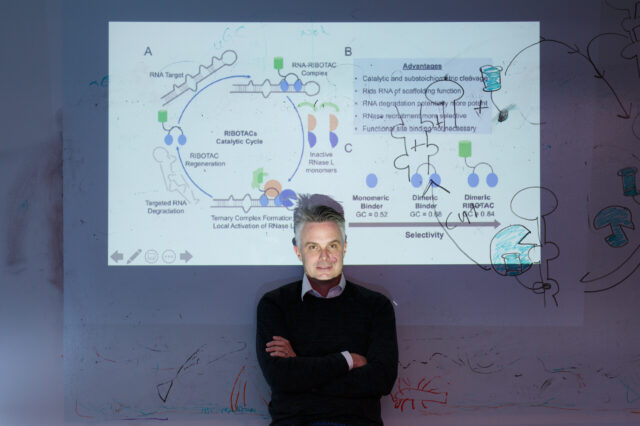- Investigator
- Adolfo Ramirez-Zamora
- Status
- Accepting Candidates
Ataxia
Ataxia affects the coordination required for eye movement, speech, limb movement, balance and movement. It can be a symptom within a wide range of disorders, or it can occur as a standalone disorder.
The symptoms of ataxia can have a variety of causes including genetic changes, injuries, inflammation, stroke, tumors and infections. Depending on the reason for ataxia, the disorder can sometimes be treated or reversed.
What is ataxia?
Ataxia occurs when you have a problem that affects your body's coordination. Ataxia can cause you to move in uncertain or clumsy ways. This is because ataxia affects the cerebellum, a part of your brain, or your inner ears and other parts of your nervous system that coordinate muscle movement.
Ataxia can refer to a group of disorders or a symptom of a specific disease.
Ataxia, as a symptom, is common. Conditions that can cause symptoms of ataxia include neuropathy, Parkinson’s disease, multiple sclerosis, dystonia, epilepsy and more.
Ataxia, as a disorder, is less common and often occurs with a specific genetic mutation. Examples of ataxia as a disorder include Friedreich’s ataxia and spinocerebellar ataxia.
What are the three main types of ataxia?
There are three main types of ataxias: cerebellar ataxia, sensory ataxia and vestibular ataxia.
Spinocerebellar ataxia is a type of ataxia that affects the brain stem and cerebellum, a part of the brain responsible for controlling coordination and balance.
Sensory ataxia is a type of ataxia that affects the brain’s automatic ability to sense where each body part is in space to maintain balance.
Vestibular ataxia is a type of ataxia that affects the inner ear, which is responsible for balance, coordination, and spatial awareness.
What causes ataxia?
Because the term ataxia covers multiple types of ataxia, there are also many possible causes of ataxia. The most common causes fall into one of three categories:
Inherited ataxia develops because of changes or mutations in genes. Inherited ataxias are passed from generation to generation in families. Examples of inherited ataxia include spinocerebellar ataxia, episodic ataxia, Friedreich’s ataxia, ataxia telangiectasia and mitochondrial ataxia. There are currently no cures for inherited ataxia, but genetic testing can tell you if a gene mutation is present.
Acquired ataxia develops because of an infection or injury, toxin or nutritional deficiency rather than being inherited from a family member. Examples of acquired ataxia include autoimmune ataxia, B12 deficiency, or side effects from certain medications. Some acquired ataxias can be temporary or reversible.
Idiopathic ataxia develops without a known reason or cause. Doctors are not sure why idiopathic ataxia develops, and more research is needed to understand idiopathic ataxia. Examples include sporadic ataxia and multiple system atrophy, which may have a genetic component that has yet to be identified.
How common is ataxia?
Ataxia is a relatively rare disease, which means that it is not very common.
Inherited ataxia, caused by genetic mutations, is thought to affect between 5-10 people per 100,000. Idiopathic ataxia occurs in a similar number of people.
What are the symptoms of ataxia?
Ataxia can cause different symptoms depending on the person.
Common symptoms of ataxia include:
- Trouble with balance and coordination
- Difficulty walking or moving around easily
- Loss of movement control (shaky hands, arms and legs)
- Slurred speech or difficulty swallowing
- Wide-based gait (manner of walking)
- Difficulty with writing and eating
- Involuntary movement
- Slow or unusual eye movements
How is ataxia diagnosed?
Diagnosing ataxia usually involves a physical exam by a doctor in movement disorders or neuromuscular medicine. They will look at your movement and coordination and may ask questions about your medical and family history to see if there is a genetic cause to your ataxia.
In some cases, your UF Health care team may order additional tests to help diagnose ataxia. Tests can include blood tests, imaging tests such as an MRI or CT scan, and nerve conduction studies. These tests can help your care team see what is going on inside the body and identify any underlying causes of the ataxia.
How is ataxia treated?
Treatment options depend on the underlying cause of ataxia.
In some cases, treating the underlying cause may help improve the symptoms of ataxia. For example, if ataxia is caused by an infection, treating the infection may help reduce the symptoms.
In other cases, there may not be a cure for ataxia, but there are ways to manage the symptoms. At UF Health, our team uses a multidisciplinary approach to support you and optimize your quality of life.
As a patient at UF Health, your care team will work with you to determine the best treatment plan for you. Treatment plans can include physical therapy to improve balance and movement, occupational therapy to help with daily activities, and speech therapy to improve communication skills.
You may also benefit from medications to help manage your symptoms. For example, some medications can help reduce tremors and improve muscle control.
During your appointment at UF Health, your care team may share information about active research opportunities. Clinical trials are essential for advancing our knowledge and understanding of ataxia, and for developing new and effective treatment and medication options that can improve the lives of people living with ataxia.
Our locations
Our experts
-

-
Matthew R Burns, MD, PhDNeurologist

-

Clinical Trials: Ataxia
UF Health research scientists make medicine better every day. They discover new ways to help people by running clinical trials. When you join a clinical trial, you can get advanced medical care. Sometimes years before it's available everywhere. You can also help make medicine better for everyone else. If you'd like to learn more about clinical trials, visit our clinical trials page. Or click one of the links below:
Spinocerebellar ataxias (SCA) are genetic neurological diseases that cause imbalance, poor coordination, and speech difficulties. There are different kinds of SCA and this study will focus on types 1, 2,3, and 6 (SCA 1, SCA 2, SCA 3 , also known as…
- Investigator
- Sub Subramony
- Status
- Accepting Candidates
- Ages
- 6 Years - N/A
- Sexes
- All
This is a natural history study prospectively investigating neuroimaging markers of disease progression in children and adults with Friedreich ataxia (FA). There will be three assessment periods (baseline, 12 and 24 months). The study will include…
- Status
- Accepting Candidates
- Ages
- 5 Years - N/A
- Sexes
- All
News and Patient Stories: Ataxia
Climbing a new path allows chemists to ascend cancer’s steepest research challenges
May 24, 2023
The cancer gene MYC drives unrestrained cancer cell growth, but has proved a difficult drug target. Nature-inspired compounds succeed by chopping up MYC’s RNA.…
UF Health Cancer Center, +1 more

UF Scripps researcher’s drug-discovery method shows promise against aggressive breast cancer
May 12, 2022
UF Scripps Biomedical Research scientist Matthew Disney, Ph.D. has found yet another groundbreaking approach to a problem that has long vexed scientists: How…
UF Health Cancer Center, +1 more



